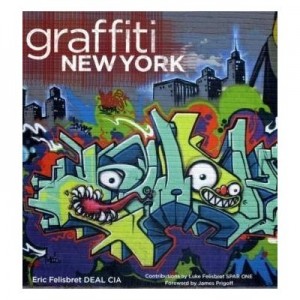 Former graffiti artist and founder of @149ST.com, Eric Felisbret can proudly add photographer and author to his resume after recently debuting his first book, Graffiti New York, a documentation of graffiti’s birth to present-day development.
Former graffiti artist and founder of @149ST.com, Eric Felisbret can proudly add photographer and author to his resume after recently debuting his first book, Graffiti New York, a documentation of graffiti’s birth to present-day development.
Despite the book’s title, it not only journeys through the movement in New York City, but also how it inspired people in other parts of the world to join in by way of imitation and the power of the media. The documentary Style Wars (1983) directed by Tony Silver and the book Subway Art (1984) by Martha Cooper and Henry Chalfant are mentioned as immense contributing factors in the book. Another section features the trend of indoor graffiti in galleries and museums.
Not forgetting that graffiti is also considered vandalism, Felisbret focuses a portion of the book to well-known law enforcement officers that gained attention by the number of vandals they arrested.
“It starts with simple signatures and tags. In the early days, the styling of the names wasn’t sophisticated. The book follows it’s evolution into more complex forms of graffiti like pieces. Those lead to more complex graffiti of letter form, lots of colors involved and eventually subway cars and then the large scale murals across the city as well as the other type of graffiti that the public views as complete vandalism,†he said.
Felisbret’s curiosity for the spray-painted wall signatures stems from his elementary school days when graffiti was a rising problem in the five boroughs. The MTA’s version of the Drug Abuse Resistance Education (D.A.R.E) program was set in place to discourage youngsters from picking up the bad habit as they grew up on the streets by showing a vibrant slideshow of graffiti.
“It sort of backfired for me. Instead of making me not want to do it, it got me really enthusiastic, because I found the slideshow very interesting. After that I started to pay a lot more attention to it and eventually I picked up a marker and got involved myself,†said Felisbret.
A temporary art form by nature due to buffs, Felisbret began photographing throw ups he found interesting in ’77 as a way to capture it’s beauty. By the mid ‘90s he had a collection of photos, built friendships with significant graffiti artists and absorbed as much graffing knowledge as he could, calling himself a “graffiti geek.â€
One thing Felisbret came to learn quickly that he found strange was that there are people of all ages involved. Despite the public’s misconception of graffiti artists being 13 to 17-year-olds they only make up a small portion of the movement while the more complex murals are done by people in their 30s and 40s.
“When the opportunity came up Jim Prigoff the author of Spray Can Art [1987] connected me with the publisher, Abrams and I decided I wanted to do something with all this knowledge and large collection of photographs I’ve pulled together,†he said.
Unintentionally, launching his career through his love of graffiti, Felisbret’s next step to produce his book was the use of the internet by going public with his site @149St in 1998. Because the internet could be updated, he and his brother, Luke could continually add new and overlooked artists posing to be a better immediate fit.
“What was good about the choice of using the internet for the documentary project was the fact that a lot of old school graffiti artists that had disappeared off the face of the earth -as far as anyone was concerned- came out of the woodwork and approached us saying, ‘I would like to do an interview for the site.’ That gave us the opportunity to speak to people we never would have been able to find, because we had no sense of where they had moved,†he said.
Being unbiased and showing every aspect of the spectrum, the book features all sorts of artists from people who transitioned from graffiti to fine art to those who felt their work was better left on the streets.
The group TATs Cru, initially tagging in subways and famous for their attention to detail, made their way to having accounts with Nike and Sony while other highly respected artists such as Dondi White, Lee Quinones and Chris Daze Ellis preferred to stay true to their roots.
Unfortunately, the movement wasn’t always open to everyone. Tagging was the game and men were the supreme players leaving no room for the ladies. Felisbret’s book takes you through the struggle and determination of one woman ready to face off with any man.
“Lady Pink was one of the few women involved in the late ‘70s, early ‘80s. She was kind of alone in a sense. Not only was she one of the few women doing it, she didn’t have the support of the other graffiti writers around her,†he said. “It was a very male dominated field and a lot of people felt threatened. They weren’t welcoming to her so it was difficult for her to participate. She was very aggressive and made a good name for herself. In fact, some of her work is in art galleries.â€
As the times have changed so has painting styles, gender superiority and tolerance.
“Its much different then when I was doing it. In the 70s, it was completely unacceptable now it’s in galleries. All sorts of media have found that there’s ways to monetize it. But at the same token there is still a lot of opposition to it, because there are aspects of it that are seen as vandalism,†he said.

Leave a Reply